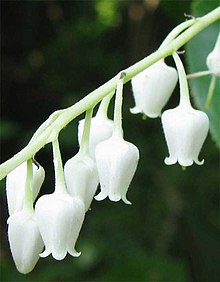Sauerbaum
| Sauerbaum | ||||||||||||
|---|---|---|---|---|---|---|---|---|---|---|---|---|

Sauerbaum ( Oxydendrum arboreum ) |
||||||||||||
| Systematics | ||||||||||||
|
||||||||||||
| Scientific name of the tribe | ||||||||||||
| Oxydendreae | ||||||||||||
| Cox | ||||||||||||
| Scientific name of the genus | ||||||||||||
| Oxydendrum | ||||||||||||
| DC. | ||||||||||||
| Scientific name of the species | ||||||||||||
| Oxydendrum arboreum | ||||||||||||
| ( L. ) DC. |
The sour tree ( Oxydendrum arboreum ) is the only plant species of the only genus Oxydendrum of the Oxydendreae tribe , which belongs to the heather family (Ericaceae). The trivial names , in German Sauerbaum, in English “Sourwood” and the botanical generic name Oxydendrum - Greek: oxy for sour and dendron for tree - refer to the sour-tasting leaves.
description
The sour tree forms deciduous, medium-sized trees (life form: phanerophyte) and can reach heights of about 12 to 15 meters. This slowly growing species is shade-tolerant but can also get by in sunny locations. The rusty-brown bark is initially smooth and then cracks. The alternate leaves are simple, 10 to 18 cm long and variable in shape. The leaf margin is smooth to serrate. The scarlet autumn color of the leaves is striking. After a fire, new shoots take place from the rootstock or from the trunk.
At the branch ends (terminal) are long in 20 to 25 centimeters, rispigen total inflorescences few traubige part inflorescences together. There are bracts and bracts in pairs. The stalked, sweetly scented, five-fold flowers are hermaphroditic and radial symmetry . The five sepals are fused at their base. The white, about 8 mm long petals are bell-shaped fused with only short corolla lobes. There are two circles with five fertile stamens each. The straight stamens and tetrasporangiaten anther have no appendages each. Five carpels have become a top permanent ovary grown. The lily of the valley-like inflorescences bloom in late summer June to August.
It is the only species within the Ericaceae that has an elongated egg-shaped capsule ; it is 6 to 13 mm long. The capsule fruit contains many tiny seeds (one report writes from 4,080,000 to 12,250,000 seeds / kg). The capsule fruits ripen in the same year as the flowering from September to October, open in winter and then do not release the seeds all at once.
The number of chromosomes is 2n = 24.
ecology
The white-tailed deer ( Odocoileus virginianus ) eats the young twigs.
Oberea tripunctata and Oncideres cingulata attack the branches. The larva of the white bear moth ( Hyphantria cunea ) and that of Citheronia regalis eat the leaves.
Occurrence
The sour tree comes from the east of the USA . It occurs in Alabama, Florida, Georgia, Indiana, Kentucky, Louisiana, Maryland, Missouri, New Jersey, New York, North Carolina, Ohio, Pennsylvania, South Carolina, Tennessee, Virginia and West Virginia. The main distribution area ranges from 30 to 40 ° N and from 75 to 92 ° W. The largest trees of this species grow on the western slopes of the Great Smoky Mountains in Tennessee . Acidic soil is preferred (this species can handle pH 4 to 6). This species is also frost hardy in Central Europe ( hardiness : USDA climate zones 5–9).
use
The reddish-brown, hard and heavy wood is not used very often. Tool handles are made from it and used as firewood.
Sauerbaum is used for spice mixtures. The flowers are important for honey production .
The sour leaves are eaten raw. Medical uses were investigated.
The sour tree is used as an ornamental wood because of its beautiful autumn color .
swell
- Oxydendreae at the Ericaceae homepage from Kathleen A. Kron.
- USDA data sheet.
- Kathleen A. Kron, WS Judd, PF Stevens, DM Crayn, AA Anderberg, PA Gadek, CJ Quinn & JL Luteyn: A phylogenetic classification of Ericaceae: Molecular and morphological evidence. , in Botanical Review , 68, 2002, pp. 335-423. ( Summary )
Individual evidence
- ^ A b Walter S. Judd: Oxydendrum de Candolle. In: Flora of North America, vol. 8. [1] .
- ↑ Entry in Plants for a Future


